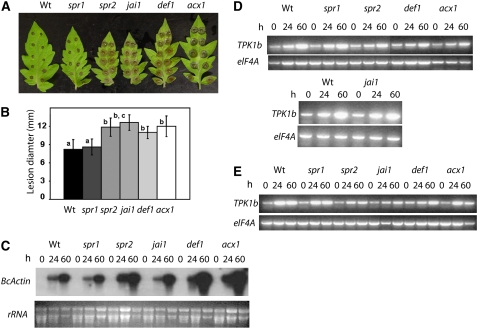Figure 5.
Tomato JA and Wound Response Genes Are Required for Botrytis Resistance.
(A) Botrytis disease symptoms on leaves of indicated genotypes.
(B) Disease lesion size.
(C) Fungal growth.
(D) Botrytis-induced TPK1b gene expression.
(E) Wound-induced TPK1b gene expression in the tomato JA and/or wound response mutants.
The pictures in (A) and lesion sizes in (B) are from 3 DAI with Botrytis (3 × 105 spores/mL). Fungal growth in (C) is based on the accumulation of Botrytis ActinA RNA as detected by RNA gel blot hybridization. In (C), total RNA (15 μg) was loaded per lane. In (D) and (E), RT-PCR was performed as described in Methods. The tomato translation initiation factor (eIF4A) gene was amplified in parallel to demonstrate relative quality and quantity of the cDNA. Experiments were repeated at least three times with similar results. h, h after inoculation.

